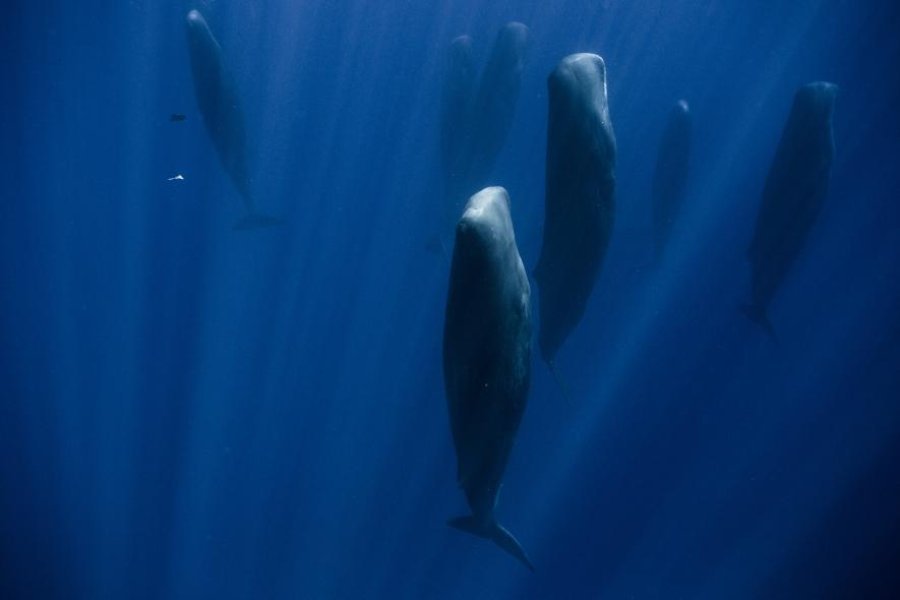The Surprising Sleep Habits of Sperm Whales: Vertical Naps in the Deep Blue
Sperm whales are known for their immense size, intelligence, and mysterious behavior in the deep ocean. But one of the most fascinating aspects of these majestic creatures is how they sleep—an unusual behavior that remained largely unknown until recent years. When sperm whales need to rest, they don’t just float aimlessly; instead, they take a deep breath, dive down to about 45 feet, and arrange themselves in perfectly-level, vertical patterns. For up to two hours at a time, these sleep-loving giants stay motionless and still, floating in synchronized pods of 5 to 6 whales. But it wasn’t until 2008 that this sleep pattern was officially documented, and it took until 2017 for stunning photographs of this behavior to be captured in the wild.
Sperm Whales and Their Unique Sleep Routine
Unlike humans, who typically lie down to sleep, sperm whales sleep while remaining vertical in the water. They take a deep breath before diving to a depth of about 45 feet (13 meters) where they rest in a group, suspended in perfect formation. This behavior is part of their complex sleep cycle, which involves alternating periods of deep rest and active swimming. The reason they sleep vertically is still not fully understood, but experts believe that it may help them conserve energy or maintain an efficient body position while resting.

These whales sleep for up to two hours at a time, but during their rest, they remain still and silent. They continue to breathe involuntarily, rising to the surface every 15-20 minutes for air before resuming their vertical slumber. The formation is typically maintained within pods of 5 or 6 whales, and it is believed that this arrangement may provide protection, as the group is able to remain more alert to potential threats while they rest.
A Fascinating Discovery
It wasn’t until a 2008 study by researchers in the Mediterranean that the vertical sleeping behavior of sperm whales was officially documented. Before this groundbreaking discovery, scientists had only speculated about the whales’ sleep patterns. But it wasn’t just the scientific community that was in the dark about this behavior—no one had managed to capture good images of sperm whales sleeping vertically, either.
That is, until 2017. American photographer Patrick Dykstra was documenting sperm whales for his book when he happened upon this extraordinary sight. While working in the Mediterranean Sea, he captured stunning images of sperm whales sleeping in their vertical pods. His incredible photographs showcased the surreal beauty of these majestic creatures, resting in their seemingly peaceful and synchronized formations. This moment marked a turning point in both scientific understanding and public awareness of how these magnificent animals sleep.

Why Do Sperm Whales Sleep Vertically?
The precise reasons behind the vertical sleeping behavior remain somewhat mysterious. However, there are a few theories. One popular idea is that sleeping in a vertical position allows sperm whales to conserve energy by maintaining an efficient swimming posture. Sperm whales are deep divers, often spending hours at a time in the depths of the ocean, so their sleep cycles may help them stay alert and ready for the next dive.
Another possible explanation is that this sleep pattern helps protect the whales from predators, particularly orcas. By sleeping in pods and staying close together, sperm whales may be better able to defend themselves against any threats. The vertical arrangement allows them to stay positioned near the surface to breathe without disturbing their natural rest cycle.
A Glimpse Into Whale Intelligence and Behavior
Sperm whales are some of the most intelligent creatures on Earth, and their complex sleep behavior is just one example of their fascinating biological and social capabilities. These whales are known for their large brains, with the largest brain of any animal species, and their highly developed social structures. Their sleep patterns are just one aspect of the many mysteries still waiting to be uncovered about these magnificent beings.
Conclusion
The discovery of vertical sleeping sperm whales has added another layer to the enigmatic lives of these creatures. With stunning photography and groundbreaking research, we’ve gained a deeper understanding of their sleep habits and behavior. From their mysterious vertical slumbers to their complex social structures, sperm whales continue to captivate scientists and nature lovers alike. Patrick Dykstra’s photographs and the studies that followed have provided the world with a rare glimpse into the world of these ocean giants, reminding us of how much we still have to learn about the incredible creatures that share our planet.
Want to learn more about the secrets of the ocean? Dive deeper into the world of sperm whales and other fascinating marine life, and uncover the mysteries of the deep blue sea.
